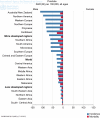Men with a susceptibility to prostate cancer and the role of genetic based screening
- PMID: 29594021
- PMCID: PMC5861282
- DOI: 10.21037/tau.2017.12.30
Men with a susceptibility to prostate cancer and the role of genetic based screening
Abstract
Prostate cancer is the second most common malignancy affecting men worldwide, and the commonest affecting men of African descent. Significant diagnostic and therapeutic advances have been made in the past decade. Improvements in the accuracy of prostate cancer diagnosis include the uptake of multi-parametric MRI and a shift towards targeted biopsy. We also now have more life-prolonging systemic and hormonal therapies for men with advanced disease at our disposal than ever before. However, the development of robust screening tools and targeted screening programs has not followed at the same pace. Evidence to support population-based screening remains unclear, with the use of PSA as a screening test limiting our ability to discriminate between clinically significant and insignificant disease. Prostate cancer has a large heritable component. Given that most men without risk factors have a low lifetime risk of developing lethal prostate cancer, much work is being done to further our knowledge of how we can best screen men in higher risk categories, such as those with a family history (FH) of the disease or those of African ancestry. These men have been reported to carry upwards of a two-fold increased risk of developing the disease at an earlier age, with evidence suggesting poorer survival outcomes. In men with a FH of prostate cancer, this is felt to be due to rare, high-penetrance mutations and the presence of multiple, common low penetrance alleles, with men carrying specific germline mutations in the BRCA and other DNA repair genes at particularly high risk. To date, large scale genome-wide association studies (GWAS) have led to the discovery of approximately 170 single nucleotide polymorphisms (SNPs) associated with prostate cancer risk, allowing over 30% of prostate cancer risk to be explained. Genomic tests, utilising somatic (prostate biopsy) tissue can also predict the risk of unfavourable pathology, biochemical recurrence and the likelihood of metastatic disease using gene expression. Targeted screening studies are currently under way in men with DNA repair mutations, men with a FH and those of Afro-Caribbean ethnicity which will greater inform our understanding of disease incidence and behaviour in these men, treatment outcomes and developing the most appropriate screening regime for such men. Incorporating a patient's genetic mutation status into risk algorithms allows us an opportunity to develop targeted screening programs for men in whom early cancer detection and treatment will positively influence survival, and in the process offer male family members of affected men the chance to be counselled and screened accordingly.
Keywords: Prostate cancer; genetic screening; single nucleotide polymorphisms (SNPs).
Conflict of interest statement
Conflicts of Interest: The authors have no conflicts of interest to declare.
Figures
Similar articles
-
The PROFILE Feasibility Study: Targeted Screening of Men With a Family History of Prostate Cancer.Oncologist. 2016 Jun;21(6):716-22. doi: 10.1634/theoncologist.2015-0336. Epub 2016 May 5. Oncologist. 2016. PMID: 27151655 Free PMC article.
-
Prostate-Specific Antigen-Based Screening for Prostate Cancer: A Systematic Evidence Review for the U.S. Preventive Services Task Force [Internet].Rockville (MD): Agency for Healthcare Research and Quality (US); 2018 May. Report No.: 17-05229-EF-1. Rockville (MD): Agency for Healthcare Research and Quality (US); 2018 May. Report No.: 17-05229-EF-1. PMID: 30085502 Free Books & Documents. Review.
-
Genetics of prostate cancer and its utility in treatment and screening.Adv Genet. 2021;108:147-199. doi: 10.1016/bs.adgen.2021.08.006. Epub 2021 Oct 19. Adv Genet. 2021. PMID: 34844712
-
More advantages in detecting bone and soft tissue metastases from prostate cancer using 18F-PSMA PET/CT.Hell J Nucl Med. 2019 Jan-Apr;22(1):6-9. doi: 10.1967/s002449910952. Epub 2019 Mar 7. Hell J Nucl Med. 2019. PMID: 30843003
-
Folic acid supplementation and malaria susceptibility and severity among people taking antifolate antimalarial drugs in endemic areas.Cochrane Database Syst Rev. 2022 Feb 1;2(2022):CD014217. doi: 10.1002/14651858.CD014217. Cochrane Database Syst Rev. 2022. PMID: 36321557 Free PMC article.
Cited by
-
Analysis of Pros and Cons in Using [68Ga]Ga-PSMA-11 and [18F]PSMA-1007: Production, Costs, and PET/CT Applications in Patients with Prostate Cancer.Molecules. 2022 Jun 16;27(12):3862. doi: 10.3390/molecules27123862. Molecules. 2022. PMID: 35744985 Free PMC article.
-
Updates in Prostate Cancer Research and Screening in Men at Genetically Higher Risk.Curr Genet Med Rep. 2021;9(4):47-58. doi: 10.1007/s40142-021-00202-5. Epub 2021 Oct 8. Curr Genet Med Rep. 2021. PMID: 34790437 Free PMC article. Review.
-
RAD51 and XRCC3 Polymorphisms Are Associated with Increased Risk of Prostate Cancer.J Oncol. 2019 May 2;2019:2976373. doi: 10.1155/2019/2976373. eCollection 2019. J Oncol. 2019. PMID: 31186630 Free PMC article.
-
Application Areas of Traditional Molecular Genetic Methods and NGS in relation to Hereditary Urological Cancer Diagnosis.J Oncol. 2020 Jun 17;2020:7363102. doi: 10.1155/2020/7363102. eCollection 2020. J Oncol. 2020. PMID: 32612654 Free PMC article. Review.
-
The potential of cell-free and exosomal microRNAs as biomarkers in liquid biopsy in patients with prostate cancer.J Cancer Res Clin Oncol. 2022 Oct;148(10):2893-2910. doi: 10.1007/s00432-022-04213-9. Epub 2022 Aug 4. J Cancer Res Clin Oncol. 2022. PMID: 35922694 Free PMC article. Review.
References
Publication types
Grants and funding
LinkOut - more resources
Full Text Sources
Other Literature Sources
Research Materials
Miscellaneous

